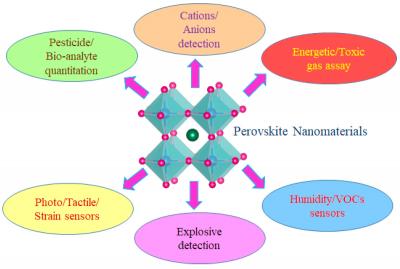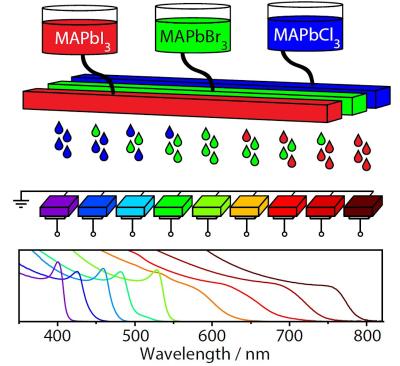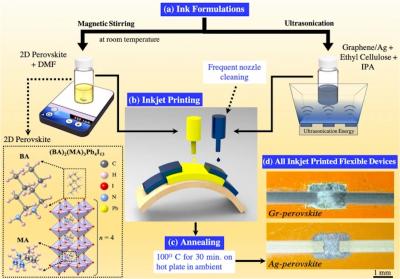Perovskites are materials that share a crystal structure similar to the mineral called perovskite, which consists of calcium titanium oxide (CaTiO3).
Depending on which atoms/molecules are used in the structure, perovskites can possess an impressive array of interesting properties including superconductivity, ferroelectricity, charge ordering, spin dependent transport and much more. Perovskites therefore hold exciting opportunities for physicists, chemists and material scientists.

Sensors are devices that detect events that occur in the physical environment (like light, heat, motion, moisture, pressure, and more), and respond with an output, usually an electrical, mechanical or optical signal. The household mercury thermometer is a simple example of a sensor - it detects temperature and reacts with a measurable expansion of liquid. Sensors are everywhere - they can be found in everyday applications like touch-sensitive elevator buttons and lamp dimmer surfaces that respond to touch, but there are also many kinds of sensors that go unnoticed by most - like sensors that are used in medicine, robotics, aerospace and more.
Traditional kinds of sensors include temperature, pressure (thermistors, thermocouples, and more), moisture, flow (electromagnetic, positional displacement and more), movement and proximity (capacitive, photoelectric, ultrasonic and more), though innumerable other versions exist. sensors are divided into two groups: active and passive sensors. Active sensors (such as photoconductive cells or light detection sensors) require a power supply while passive ones (radiometers, film photography) do not.
Perovskite materials’ host of exciting properties, such as being rather tolerant to defects (unlike metal chalcogenides) and not requiring surface passivation to retain high quantum yields, make them especially suited for sensing applications. The sensitivity, selectivity, and stability of many perovskite nanomaterials has directed many researchers to devote the most attention to chemical sensors, but perovskites are suitable for other types as well. Perovskites are being studied by numerous research groups for use in various types of sensors.
Researches show how water can be a positive factor for perovskite crystal growth
Researchers from ARC Centre of Excellence in Exciton Science, Monash University, University of Sydney and CSIRO Manufacturing have shown how water could be the 'secret ingredient' in a simple way to create perovskite crystals.
Ordinarily, water is kept as far away as possible during the process of creating perovskites as the presence of moisture is severely harmful to them. That’s why perovskites for scientific research are often made via spin coating in the sealed environment of a nitrogen glove box. However, in their new work, the researchers have found a simple way to control the growth of phase-pure perovskite crystals by harnessing water as a positive factor. This liquid-based mechanism works at room temperature, so the approach remains cost effective.
An international team secures grant to develop perovskite-based X-ray detectors
A new project, one of eight that successfully secured funding from the Hebrew University of Jerusalem (HUJI) ' Zelman Cowen Academic Initiatives (ZCAI), Australia this year, will focus on developing X-ray detectors from metal halide perovskite materials.
Associate Professor Guohua Jia, from Curtin University's School of Molecular and Life Sciences, said X-ray detectors based on metal halide perovskites are highly sensitive, enabling a very low detection limit, meaning they could lower medical expenses and reduce the risk of radiation to patients.
Researchers develop perovskite-based artificial retina
KAUST researchers have developed an artificial electronic retina based on perovskite materials, that can "see" in a similar way to the human vision system and can recognize handwritten digits.
The team designed and fabricated an array of photoreceptors that detect the intensity of visible light via a change in electrical capacitance, mimicking the behavior of the eye's rod retina cells. When the array was connected to an electronic CMOS-sensing circuit and a spiking neural network (a single-layer network with 100 output neurons), it was able to recognize handwritten numbers with an accuracy of around 70%.
Researchers use inkjet printing to produce a large range of photodetector devices based on a hybrid perovskite semiconductor
Researchers from Innovation Lab HySPRINT at Helmholtz-Zentrum Berlin (HZB) and Humboldt Universität zu Berlin (HU) have used an advanced inkjet printing technique to produce a large range of photodetector devices based on a hybrid perovskite semiconductor.

By mixing three inks, the researchers were able to precisely tune the semiconductor properties during the printing process. Inkjet printing is already an established fabrication method, allowing fast and cheap solution processing. Extending the inkjet capabilities from large area coating towards combinatorial material synthesis could open the door to new possibilities for the fabrication of different kinds of electronic components in a single printing step.
Researchers develop a thin and flexible perovskite-based scanner for fingerprints
Researchers from TNO at Holst Centre, Solliance and TU/e have jointly developed a thin and flexible perovskite-based scanner for fingerprints.

Low-resolution image-sensor arrays have been demonstrated in the past, but the high-resolution, high pixel-count image sensors suitable for commercial applications have not yet been truly achieved. The thin and flexible scanner in this new work is based on metal-halide perovskites (MHPs). Gerwin Gelinck, Chief Technology Officer TNO at Holst Centre, elaborates on the new study: 'Perovskites are marvelous materials! For the first time we show that these materials are also very good for light imaging and sensing applications. When combined with display-like transistors, we made a scanner that can capture high-resolution color images as well as biometric fingerprinting'.
Researchers create a perovskite-based scanner for fingerprints and documents
Researchers at the Dutch Organization for Applied Scientific Research and Eindhoven University of Technology in the Netherlands have recently used a solution-processed photodetector made of a metal halide perovskite to fabricate a thin and flexible scanner. This scanner can be used to scan both fingerprints and paper documents.
"Fabricating photodetectors with low dark currents and integrating them into high-resolution backplanes remains challenging," Albert J. J. M. van Breemen and his colleagues wrote in their paper. "Here, we show that solution-processed metal halide perovskite photodiodes on top of an amorphous indium gallium zinc oxide transistor backplane can be used to create a flexible image sensor that is ~100'μm thick and has a resolution of 508 pixels per inch."
Perovskites enable simple and cheap neutron detector
Scientists at EPFL and their collaborators have developed a simple and low-cost perovskite-based device that detects neutrons. The perovskite materials used in the study are based on lead and bromine. Both contain single crystals of a compound called methylammonium lead tri-bromide.
The team first placed these crystals in the path of a neutron source. The neutrons, hitting the crystals, penetrate the nucleus of the atoms within the crystal, exciting them into a higher energy state. When they relax and decay, gamma rays are created. These gamma photons charge the perovskite, delivering a tiny current that can be estimated.
DARPA seeking research proposals for QDs and perovskite based X-ray technology
The U.S. Defense Advanced Research Projects Agency (DARPA) is currently seeking research proposals for the development of x-ray technology capable of what the agency calls "extreme photo imaging."
As part of its Extreme Photon Imaging Capability - Hard X-Ray (EPIC-HXR) project, DARPA said it is looking to develop uncooled hard x-ray imagers based on advanced nanocrystalline materials with high spatial and energy resolution, including quantum dot and perovskite materials.
Researchers report new perovskite-based synapse-like phototransistor
Researchers at the U.S. Department of Energy's National Renewable Energy Laboratory (NREL) have reported a breakthrough in energy-efficient phototransistors - devices that could someday help computers process visual information similarly to the human brain and be used as sensors in applications like self-driving vehicles.
The structures rely on metal-halide perovskites. Jeffrey Blackburn, a senior scientist at NREL and co-author of a new paper outlining the research, said: 'In general, these perovskite semiconductors are a really unique functional system with potential benefits for a number of different technologies'. 'NREL became interested in this material system for photovoltaics, but they have many properties that could be applied to whole different areas of science.'
UNT team uses additive manufacturing to print inks of 2D perovskites
A University of North Texas researcher and his team have reported a breakthrough in using additive manufacturing to further research into flexible solar panels.

Anupama Kaul, Professor of Engineering from the Departments of Materials Science and Engineering and Electrical Engineering, has successfully used additive manufacturing to print inks of 2D perovskites.
Pagination
- Previous page
- Page 4
- Next page



